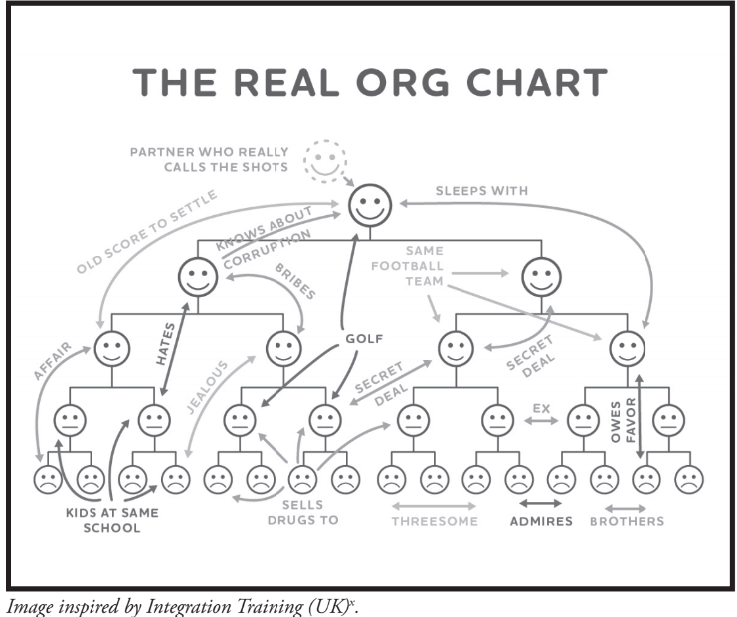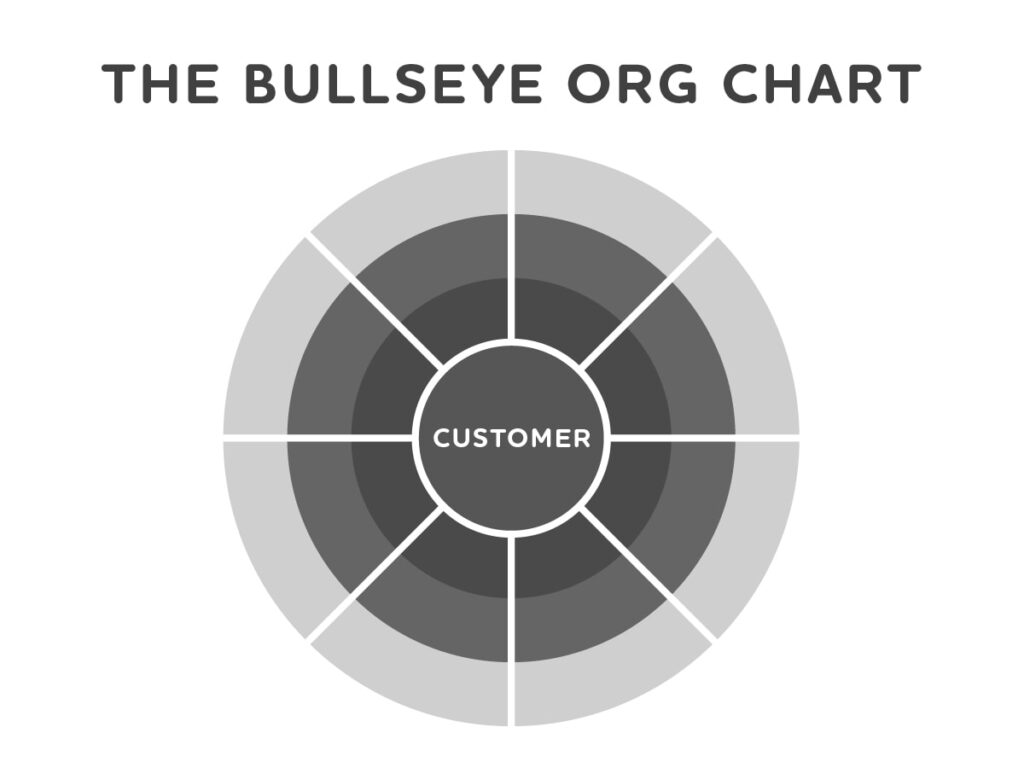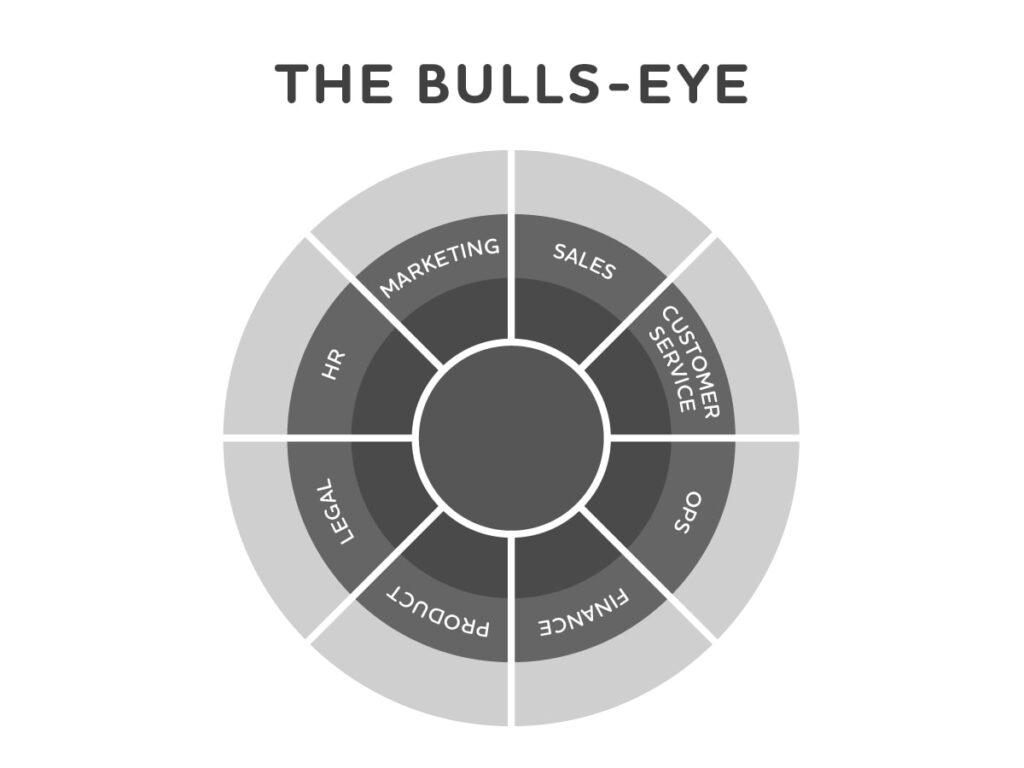Show me your company’s organizational chart, and I’ll show you everything that’s wrong with your company culture.
You’re probably familiar with the traditional organizational chart – a neat, orderly visual representation of the hierarchical structure at your company. These charts are as old as time, and they are at the core of dysfunctional company culture.
When I wrote Mean People Suck, this was one piece of the workplace puzzle I knew I needed to remove from the picture. Yep – I think we need to shatter that elegantly organized org chart and replace it with something that can fit the only organizational model that will survive past the 21st century – the customer-centric one.
Key Takeaways:
- The traditional organizational chart is outdated – in fact, it’s killing us.
- It’s time to get real with ourselves and create a real org chart so we can get an honest look at our company’s culture.
- Ultimately, we need to throw all these hierarchical diagrams and charts out and replace them with a model that puts the customer in the center.
What’s Wrong with the Classic Org Chart?
Everything.
It does look nice. It does have an honorable intent.
Traditional organizational charts are designed to clearly lay out how the organization should operate. They show who is below us, who is above us, and who is beside us. Instead of wasting time trying to figure out who is responsible for what and who makes the final call on issues, with a chart, we know:
- Who to direct questions to
- Who we allocate tasks to
- Who will be impacted by decisions
- Who has control over us at work
The problem is, these charts imply we should follow a rigid top-down structure. They inspire competition amongst co-workers, not collaboration. They foster siloes. And, honestly, they hold us back.
The thing is, humans at work aren’t the only ones who organize themselves with a top-down social hierarchy. Ants do it. Bees do it. And, baboons do it.
Not that there’s anything wrong with having an organizational structure to keep order in society – but, I think we should expect more from ourselves. And, I think empathy is the key to that evolutionary step forward (no offense monkeys).
Not only that, but studies show that this rigid hierarchy isn’t good for us. Where we are in the hierarchy – which is basically set in stone in the org chart until we claw our way up a little higher – impacts our attention, memory, how we interact with other people, and our health. Low-status primates are known to have weaker immune systems and a greater risk for heart disease, diabetes, and mental health problems.
If you’re at the bottom, you’re basically screwed.
On a group level, the org chart doesn’t inspire any hope either. It puts a damper on productivity as people forgo teamwork for personal accomplishment. It encourages a focus on upward communication – we aren’t sharing ideas with each other and bouncing off one another’s zone of genius because we don’t want to risk our chance for personal recognition.
Essentially, with this top-down organizational structure, collaboration and initiative downwards and sideways doesn’t happen. This forces everyone’s energy toward the top of the chart, robbing the foundation of strength, ingenuity, and support.
A Look at the Real Org Chart
When I was researching empathy and how people work together for Mean People Suck, I came across the real org chart, an idea created by Integration Training. Looking at the real org chart had a huge impact on me because it’s so ridiculously true!

The Real Org Chart is the authentic version of the traditional org chart. The reality is, most organizations are too complex to fit within the neat rows of boxes and lines of the org chart. There are simply too many relationships between the human beings that make up a company – from affairs and silent partners to friendships with your kid’s soccer teammate’s mom to bromances, there are dozens of interpersonal relationships going on that make the traditional organizational chart very, very messy.
Looking at the real org chart is a great exercise in looking at what we’re really working with. And, it shows us that the top-down hierarchy is a worse idea than we ever could have imagined! Not only are we operating under a counterproductive organizational structure, but we’re also working with a false one.
But, as I mentioned before, it’s about time we moved beyond org charts in general, both the neat and tidy ones and the complicated real ones.
Let’s Focus on What Matters: The Customer
The real org chart idea presented by Integration Training helped me to come up with the Bullseye Chart. Recognizing the flaws in the org chart is the first step toward evolving workplace culture into something that actually works.
The good news is, the solution is simple. There is no rigid, oppressive structure to worry about, and we can all just come to work and get along because we share a goal that lies outside of personal interests.

In Mean People Suck, I lay out the framework for a new organizational chart, the Bullseye. At the center of the bullseye is the customer. There is no vertical structure – no ladder to climb. A bullseye is a circle, and by nature, it implies we’re all supposed to work together.
Not only does this type of customer-centric organizational structure help to break down siloes, it motivates employees to focus on the end goal of the business – serving the customer.
When we all share this goal, coming to work every day with the end goal of improving the company’s services or products and enhancing the customer experience, communicating across departments, sharing ideas, and working together is the natural flow. It’s less messy. It’s less political. And, I can tell you from experience, it’s way less stressful for everyone.

The beauty of it is, you can still be human. You can have
your romantic relationships, golfing partners, and sibling bonds because these
personal relationships don’t upset the top-down power structure. The vertical
structure no longer exists.
With the Bullseye, everyone from the IT team to marketing to C-suite can pull together for a common goal. It’s empathy and teamwork in action. And, it’s the secret to tapping into the great depths of human potential a genuinely supportive culture offers.
So what do you think? Please consider picking up your copy of Mean People Suck today, and get the bonus visual companion guide as well. Or check out our services to help evolve your culture. And I would be thrilled to come present to your team on the power of empathy!


Bk3uQbZCL0n
Thanks for sharing. I read many of your blog posts, cool, your blog is very good.
x9z91CuxjSW
Thanks for sharing. I read many of your blog posts, cool, your blog is very good.
I don’t think the title of your article matches the content lol. Just kidding, mainly because I had some doubts after reading the article.
References:
steroids for muscle https://www.empireofember.com/forum/member.php?action=profile&uid=2238
winnie v steroids https://www.rogerdeakins.com/forums/users/felicaohc69/
How to Get steroids https://myvisualdatabase.com/forum/profile.php?id=108717
Short and long term effects of steroids https://tamilachat.org/community/profile/ashleighcasilla/
female bodybuilders on steroids https://classihub.in/author/kaceymenken/
Alternative to steroids https://tuffclassified.com/user/profile/JPJLarhonda
what are steroids used For in the body https://medtrain.biztechnosys.com/blog/index.php?entryid=3787
legal steroids buy https://worldwidefoodsupplyinc.com/testosterone-cycle
Steroid cycle before and after https://www.eweu-learningplatform.eu/en/forums/users/justinagallop/
can you drink alcohol while on steroids https://www.psx-place.com/members/lincolntal.266367/
steroid cream side effects long term https://elearning.smalsa.sch.id/blog/index.php?entryid=17353
best steroid for weight loss http://hev.tarki.hu/hev/author/EmilyNarva
is there a natural steroid https://classihub.in/author/staceybeche/
where can you find steroids https://reckoningz.com/what-is-the-difference-between-testosterone-and-steroids/
Where Does Anabolic Steroids Come From https://www.sitiosecuador.com/author/alineelkin3/
craig davidson steroids https://radicaltarot.com/community/profile/galetudor607858/
References:
https://www.adpost4u.com/user/profile/3375395
http://www.ogloszenia-norwegia.pl/ogloszenia-rozne-przedmioty/how-men-can-improve-their-jawlines.html
http://37.221.202.29/blog/index.php?entryid=4998
https://www.sitiosbolivia.com/author/francisco66/
https://shomokalelm.com/blog/index.php?entryid=9357
https://www.adpost4u.com/user/profile/3375368
https://myvisualdatabase.com/forum/profile.php?id=108720
https://fijicopts.org/osclass/index.php?page=user&action=pub_profile&id=618
https://www.sitiosperuanos.com/author/estelleroun/
https://www.sitiosperuanos.com/author/wendykittel/
https://tuffclassified.com/user/profile/CourtneyReg
https://www.sitiosperuanos.com/author/emelysimons/
https://reckoningz.com/your-best-guide-to-post-cycle-therapy-2024/
https://elearning.smalsa.sch.id/blog/index.php?entryid=17351
https://commealatele.com/question/post-cycle-therapy-pct-in-bodybuilding-a-comprehensive-guide/
https://radicaltarot.com/community/profile/corineo91812428/
Thanks for sharing. I read many of your blog posts, cool, your blog is very good.
Your point of view caught my eye and was very interesting. Thanks. I have a question for you.
Thanks for sharing. I read many of your blog posts, cool, your blog is very good.
Thanks for sharing. I read many of your blog posts, cool, your blog is very good. https://accounts.binance.com/en-IN/register-person?ref=UM6SMJM3
Its such as you learn my thoughts! You seem to understand a lot approximately this, like you
wrote the book in it or something. I feel that you just can do with
some % to pressure the message house a bit, however
instead of that, this is wonderful blog. A fantastic read.
I’ll definitely be back.
Hi to all, it’s genuinely a good for me to go to see this website,
it contains priceless Information.
Thanks for sharing. I read many of your blog posts, cool, your blog is very good.
Your article helped me a lot, is there any more related content? Thanks! https://www.binance.com/cs/join?ref=S5H7X3LP